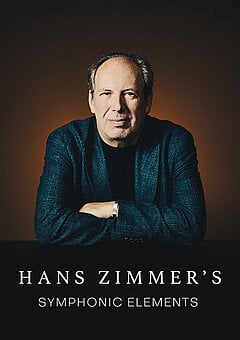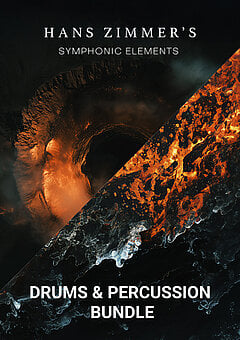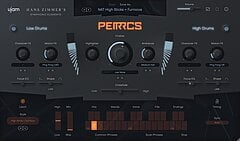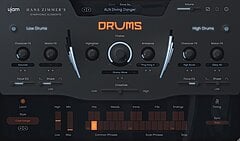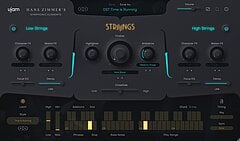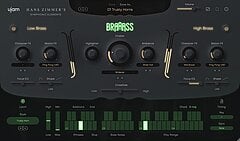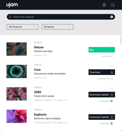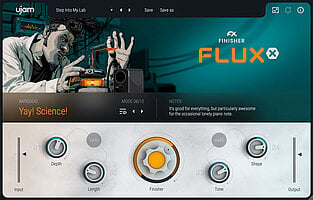Hans Zimmer on Sharing His Sounds, Technology, and the Secret to Originality
Inside Hans Zimmer’s Studio: Technology, Orchestral Plugins, and the Secret to Originality
September 26th, 2025
When Hans Zimmer sits down for an interview, you know you’re in for a treat – and the occasional surprise! One moment he’s talking about orchestras, the next he’s reminiscing about throwing a piano down a well shaft to capture the perfect sound. Recently, we had the pleasure to sit down with Hans and talk about UJAM’s plug-in series Hans Zimmer’s Symphonic Elements, his philosophy of sharing tools, and why he believes the secret to music isn’t in the sounds themselves but in how you use them.
[Discover Hans Zimmer’s Symphonic Elements Now]
Technology as the Great Enabler
Hans credits technology with playing a massive role in his career—and in civilization itself.
“Had it not been for Gutenberg, we wouldn’t be where we are now. Same for Alfred Nobel. And in music, it was the great violin builders, the organ builders, the synthesizer pioneers like Bob Moog and Tom Oberheim, and of course, our friends at Steinberg and Logic. Technology has always shaped the way we create.”
For Hans, two technologies were life-changing: synthesizers and the Roland Micro Composer, one of the earliest digital sequencers. Though it took “90% of your life to get one line going,” it opened the door to entirely new ways of making music.
Building His Own Orchestra
In the early days of sampling, Hans Zimmer and his late mentor Stanley Myers got their hands on a Fairlight sampler. While orchestras were nervous about being replaced, Zimmer saw things differently:
“If we lose the orchestras, we lose a huge part of what makes humanity great. Sampling was a way to keep orchestras alive—by showing directors what music could sound like with a real orchestra, and then convincing them to use one.”
That philosophy eventually led to Zimmer building his own orchestral sample library—painstakingly recorded at Air Lyndhurst Studios in London, with world-class players and priceless instruments like e.g. actual real Stradivari violins. “We probably spent millions of euros sampling the orchestra,” he admits. “And we’re still not done.”
Samples vs. Orchestras
So how does Zimmer decide whether to use samples or live players?
“With samples, the result is the precision and emotion of one person. But something so laser-sharp can be boring. Bring in other musicians, and they add their emotion and style—the whole thing grows in emotional quality.”
For him, samples are not a replacement for musicians, but another tool in the palette.
Why Share His Sounds?
Zimmer is famously open with his tools, from Symphonic Elements with UJAM to collaborations with developers like U-He. Why give away what many would guard as trade secrets?
“Once we’ve used the samples for a few years, they become predictable to me. Time to make a new set. The old set is still great, so why not let others have a go? After all, they’re just instruments, just tools.”
But there’s another reason too: inspiration. “It’s exciting to hear what other people come up with using the same tools. Completely different answers to the same question: how do you write a good piece of music?”
Becoming the Next Hans Zimmer? Don’t.
When asked what advice he’d give someone who wants to “be the next Hans Zimmer,” his answer is simple:
“Don’t. Become the best you you can possibly be. Learn the conventions, the craft, the microphones, the traditions that go back to Abbey Road. But after that, don’t do what I do—do what you do.”
He rattles off a list of influences to study instead: “Beethoven, Bach, Beatles, Bartók, B.B. King… even the Buggles.” And that’s only a few of the Bs.
Ultimately, Zimmer is still searching for his own identity too. “I didn’t become me. I’m still looking for who ‘me’ is, because I still try to reinvent myself every day.”
Despite this, if you’re still looking for inspiration, you can still learn how to create a Hans Zimmer style film score here.
A Message to UJAM Users
To wrap things up, Hans left a direct message for UJAM users diving into Symphonic Elements:
“This is what UJAM gave you: the Symphonic Elements. And all they are is a starting point. Elements are like little Legos. Now it’s up to you—go crazy, make your own music, knock our socks off. That was always the idea: take something I’ve played with for years, tear it apart, and make something new out of it.”
The Legacy of Curiosity
If there’s one takeaway from a conversation with Hans Zimmer, it’s that he never stops searching. For new tools, new sounds, new ways of reinventing himself. The question, as he puts it, “is always more interesting than the answer.”
And perhaps that’s the real secret: not to hold on too tightly to tools or traditions, but to keep asking what else is possible?
Stay up to date
Sign up and we’ll send you an e-mail with product news and helpful stuff every now and then. You may unsubscribe at any time.
Defy Limits
We develop software solutions that enable people to create, consume and interact with music.
